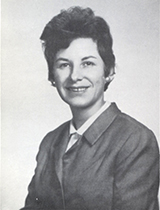Witnessing Women's History
 Dr. Joan O’Brien, V’63, had fun while making history. As noted in Penn Vet’s 1963 Scalpel yearbook, she was “the first student who was a mother of three children.” This was quite unconventional for a woman at the time. But that was Joan: she was going to do what she liked!
Dr. Joan O’Brien, V’63, had fun while making history. As noted in Penn Vet’s 1963 Scalpel yearbook, she was “the first student who was a mother of three children.” This was quite unconventional for a woman at the time. But that was Joan: she was going to do what she liked!
Fast forward to 1974: Along with countless other students, I was fortunate to call Joan a mentor. Although the quotas that limited women to two when she was admitted had long been lifted at Penn, they continued at many other schools. Indeed, Title IX was passed in 1972 and is arguably the only mechanism that lifted the explicit discrimination against women in higher education, including veterinary schools.
Joan was the only female full professor when I joined the Penn Vet faculty, and we later became colleagues and friends. A leading respiratory specialist, she provided valuable insight as I researched sleep apnea in dogs. I fondly remember many mornings carpooling to campus together.
Apropos of Women’s History Month, this issue of Bellwether highlights some of the women who, like Joan, led the way for future generations of female vets. While I know almost all of the women profiled (I did not have the honor of knowing Dr. Olive Britt), I was moved to read their stories in more detail. Of course, there are many more women worth celebrating; I hope this issue inspires conversation about Penn Vet’s numerous female trailblazers. In today’s veterinary field where women predominate, it is important to realize how recently women were overcoming explicit and perfectly legal societal barriers.
 In 1963, Joan’s graduation year, there were only 277 female veterinarians in the entire United States, according to the Journal of the American Veterinary Medical Association. In Penn Vet’s class of 2014, there were 91 female and 23 male graduates, and the School has long been ahead of the curve. The quota was challenged by farsighted faculty members in the early 1960s, long before Title IX; after Title IX, the tide of women was allowed to flow unobstructed. There were equal numbers of men and women at Penn Vet by 1978 and, by 1985, women accounted for 70 percent of the class.
In 1963, Joan’s graduation year, there were only 277 female veterinarians in the entire United States, according to the Journal of the American Veterinary Medical Association. In Penn Vet’s class of 2014, there were 91 female and 23 male graduates, and the School has long been ahead of the curve. The quota was challenged by farsighted faculty members in the early 1960s, long before Title IX; after Title IX, the tide of women was allowed to flow unobstructed. There were equal numbers of men and women at Penn Vet by 1978 and, by 1985, women accounted for 70 percent of the class.
I find it interesting that some view a predominance of women as a threat. I have experienced tremendous energy, creativity, and excellence among our current mix of students. That said, we must do a better job of encouraging both women and men to enter our field and widely sharing the rewarding, sustainable career paths a vet can take: from practice ownership, to food production, to pharma. Innovation and entrepreneurship are creating new opportunities all the time.
Since my entry into Penn Vet in 1974, I’ve lived through the changes as they unfolded. Prior to becoming Penn Vet’s first female Dean, I was the first woman named to an endowed professorship. As noted by the Women’s Veterinary Leadership Development Initiative, only six of the 30 U.S. veterinary colleges have female deans—and many of us are nearing the end of our terms. We must cultivate a stronger pipeline of female leadership, which has not kept pace with the numbers of women in the field. This is why I began the Penn Vet Wharton Executive Leadership Program early in my deanship.
Students often ask how I juggled my career while raising a family. I first tell them to find the right partner. My husband proposed on the day I got into vet school, and he has encouraged me 100 percent since. I also like to think of Joan O’Brien. She wouldn’t let anything stop her from being a vet, and she embodied delight, independence, excellence—and being herself.